US oil boom: Can the industry survive falling prices?
- Published
WATCH: The BBC's Michelle Fleury looks at how America's shale gas revolution is changing the oil game
Oil production is everywhere in Carter County, Oklahoma.
On the surface, the area is mostly empty, populated by lazily grazing cattle, with a few silos here and there.
But underneath the ground, it is a congested highway, where dozens of oil and gas firms are busy drilling horizontal wells.
"Everybody is running as fast as they can, trying to drill and take advantage of those high prices," says John Gibbs, the owner of TriPower Resources, a small oil and gas firm who has been operating in the area for over two decades.
And that has led to a boom in nearby Ardmore - the biggest town for miles, which owes much of its existence to oil, which was first discovered nearby in 1913.
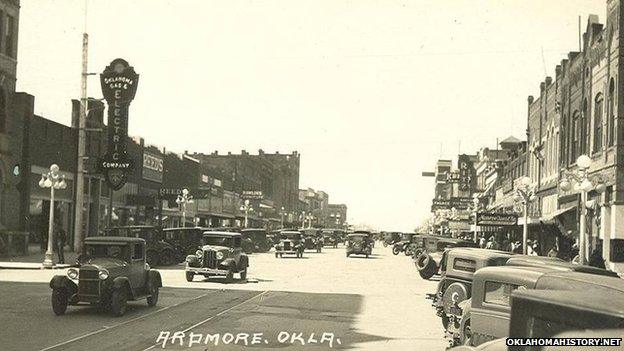
Ardmore, Oklahoma owes most of its existence to the discovery of oil nearby in 1913
Here, that underground congestion has finally broken above ground.
"We used to laugh - I came up from Houston and talking about traffic in Ardmore was a joke," says Mr Gibbs.
"Now, there's traffic in the mornings and evenings and the hotels are full."
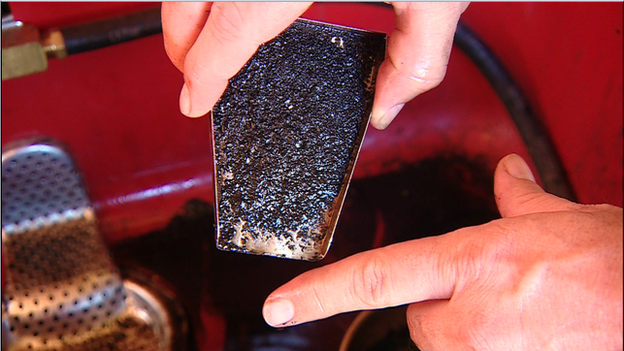
There's so much production nearby, that engineers must constantly monitor samples to ensure they haven't hit another fracking well
A global glut?
Nationwide, from North Dakota to Texas, technological improvements in the horizontal drilling used for fracking have led to an oil boom across the country, pushing US oil production to a 31-year high.
In Oklahoma, the discovery of oil resources contained within the Woodford-Cana shale has led some to speculate that the state could once again become the nation's leading oil producer, a position it last held at the turn of the 20th Century.
But all of this production is dependent on high prices, which have been plummeting over the summer.
The price per barrel of the benchmark Brent Crude index recently hit a four-year low, and that has some wondering about the economics of continued production if there is in fact a global supply war.
However, Fadel Gheit, a senior analyst covering oil at Oppenheimer and Company, says that prices would have to fall significantly to really force any producer in the US out of business.

What is the break-even price?
Why has the price of oil been so volatile?
The break-even price is when the cost of per barrel oil production is equal to (or ideally less than) the price per barrel of oil.
This is a moving target, and the break-even price for one rig or area of oil development is not necessarily the same elsewhere.
Also, the break-even price often changes, as the cost of production fluctuates.
But, as Mr Gheit notes, oil production companies are not just looking to break even - they're looking to make a profit.
"Five years ago the industry required about $90+ per barrel of oil to invest in new projects, but today this number is close to $60 or $65 per barrel," he says, mostly due to increased efficiency brought about by improving technology.
For instance, whereas it used to take two weeks to drill a new fracking well, now it takes five days.

Mr Gheit says what will probably happen - and, in some parts of the world has already begun to happen - is that companies will delay starting new projects.
"New projects will be deferred because companies will be hoping that a new technology will reduce the cost so they don't want to rush," he says.
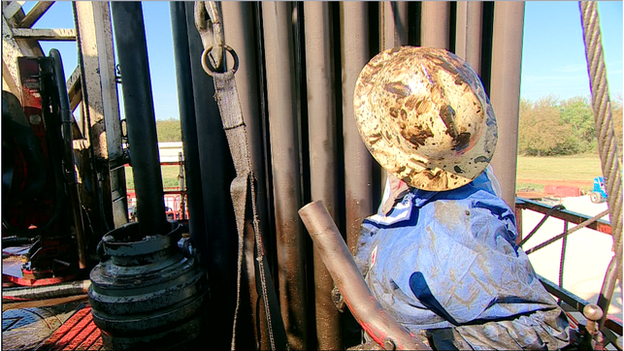
BNK says a rig like this can produce 600 barrels a day and hopefully 300,000 over its lifetime
Feast to famine
But worries still persist.
Daniel Romo, the owner of a Mexican restaurant on Ardmore's main street, says his business has benefited from the influx of workers to the area.
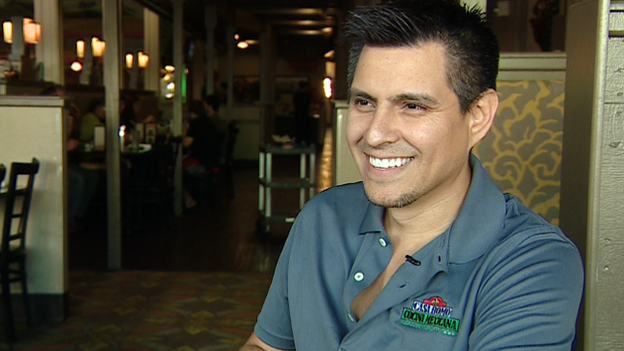
Daniel Romo says his restaurant has benefited from the influx of oil workers
He recently tripled the seating in his restaurant, and laughs as he discusses the problems that come with oil nearby - a common tale being that of the delivery workers who often phone the restaurant, lost en route to remote rigs that have ordered his signature guacamole tacos and enchiladas.
He says that although the boom times seem to be continuing for the moment, he worries about the future.
"It would definitely hurt our bottom line if the [price of] oil kept falling and falling and falling, basically to where it dried up in the area and it wasn't feasible for them to drill any more," he says.
A silver lining
For now, however, oil producers here say they have no plans to slow down.
Down a dusty stretch of road, BNK Petroleum's 11th oil rig in the area is being constructed, poking out above the scrubby trees.
Miles of metal pipe are being inserted into the ground, with a fancy, million-dollar GPS tool at the front to ensure that they are drilling towards where the oil is deep underground.
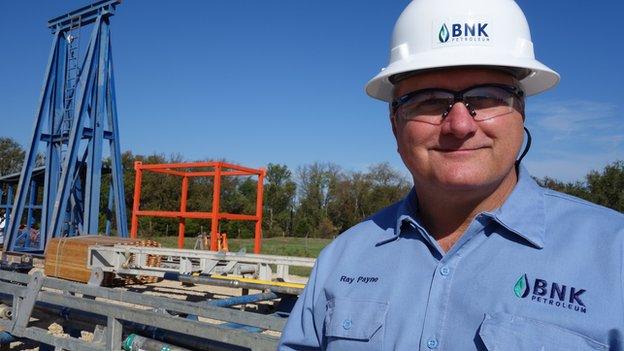
Ray Payne says BNK Petroleum has 11 wells in the Woodford-Cana shale
"It costs $8m to drill a well like this - and [hopefully] over its life over 300,000 barrels of oil," says Ray Payne, the vice-president of operations.
He says that while the falling price of oil is certainly a concern, for BNK at least, it is still high enough to make constructing a big rig like this feasible.
"Our margins are really strong here, so we will continue our development programme at the current pace, even at prices much lower than $80 a barrel," says Mr Payne.
He adds that falling prices could also be a good thing for BNK.

The area surrounding BNK's 11th rig is mostly flat and filled with grazing cattle
That's because as the price falls and some producers slow down or perhaps shut down, the amount he has to pay to suppliers could decrease as demand slows - which would make the cost of producing oil here in Carter County even less expensive than before.
Sock it away
Yet despite industry assurances, most people in Ardmore seem keen to ensure that the town does not fall prey to yet another boom and bust period.
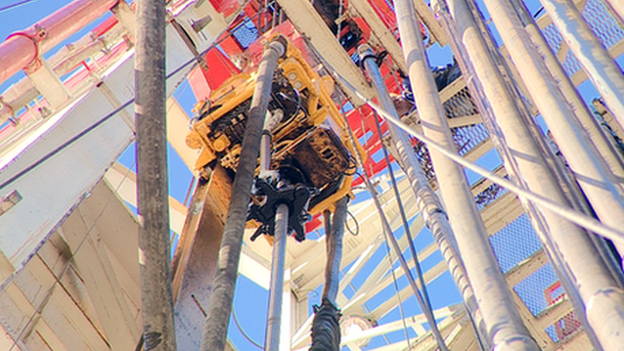
David Potts says there are many mineral rights owners looking to have oil development on their land
David Potts is an oil and gas lease broker who has been operating in the area since 1984.
"Our business is booming as far as buying leases for clients that want to drill horizontal wells," he says.
But despite the new influx of wealth, there are no expensive cars on Ardmore's main street, or multi-million dollar McMansions, external being built on the outskirts of town.
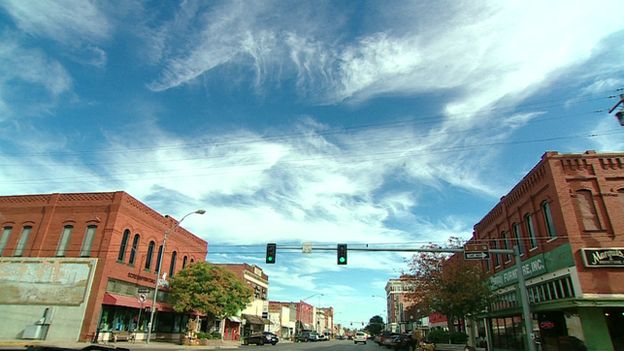
Ardmore, Oklahoma has been experiencing a rare sight - traffic during the morning commute
The glitziest symbols of the boom have been the arrival of a Chili's restaurant and a Lowe's home improvement store to the area.
That's because this is an area that has been scarred many times before - as evidenced by the still mostly empty Main Street, a casualty of bust in the 1980s.
"I think a lot of people are socking it away because they can't imagine it ever being this way again," say Mr Potts.
In order to see this content you need to have Javascript enabled. Visit BBC Webwise for full instructions.
To fill your tank you pay: